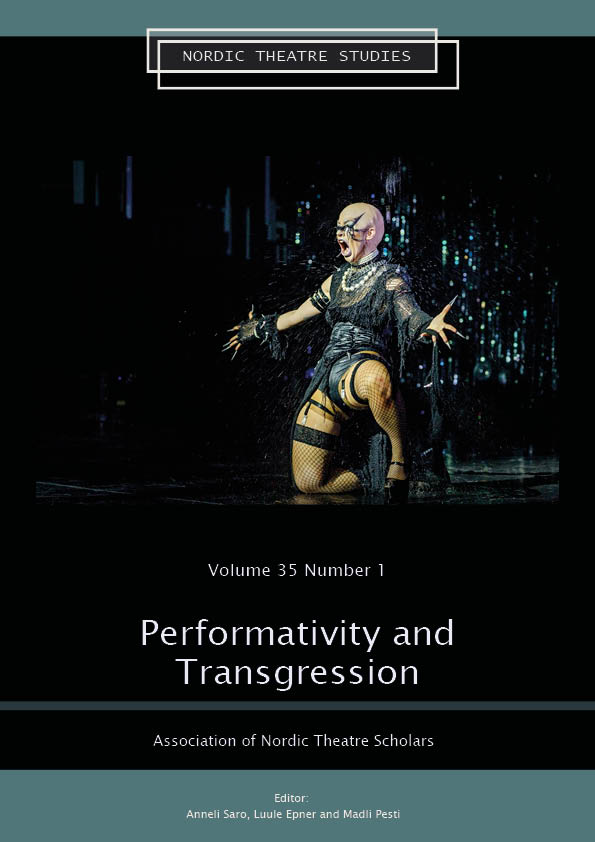When Contextual Events Become Central to Fiction
Theatre, Europe in Chaos, and the Finnish Winter War
DOI:
https://doi.org/10.7146/nts.v35i1.145378Keywords:
theatre history, theatre and politics, theatre and war, censorship, family dramaAbstract
When the Finnish Winter War erupted at the end of November 1939, it caused consternation beyond the borders of Finland; after all, mighty U.S.S.R had just attacked a small independent neighbouring country, justifying the aggression with securing its own domestic interests. I will be examining two contemporary Winter War plays and their genesis: Hagar Olsson’s Lumisota (Snowball War, 1939) depicts the threat of a fictitious war and the conflicting reactions to that threat – reactions that were put to the test during rehearsals when the prospect of war became imminent, mirroring events in the play. On the other hand, American Robert E. Sherwood set his play There Shall be No Night (1940) during the Finnish Winter War as it was being waged. The former play received a Finnish performance ban right before the Soviet attack as the portents of war reached fever pitch, and the latter initially received accolades and achieved success, but performances of the play were eventually halted when events in the European theatre of war took another turn, impacting US foreign policy.
The plays under analysis keenly exemplify drama’s firm connection with its surrounding realities. The pacificism of the playwrights themselves had to stand aside, or take on new forms, when a real war with all its political decision-making emerged from behind a fictitious story.
References
Bennett, Benjamin. 2005. All Theater is Revolutionary Theater. Ithaca and London: Cornell University Press.
Bigsby, C. W. E. 1982. A Critical Introduction to Twentieth-Century American Drama. Vol. One. 1900-1940. Cambridge and New York: Cambridge University Press.
Dunn, Susan. 2013. 1940. FDR, Willkie, Lindbergh, Hitler – the Election amid the Storm. New Haven and London: Yale University Press.
Hiedanniemi, Britta. 1980. Kulttuuriin verhottua politiikkaa. Kansallissosialistisen Saksan kulttuuripropaganda Suomessa 1933–1940. Helsinki: Otava.
Holmström, Roger. 1993. Hagar Olsson och den öppna horisonten. Liv och diktning 1920–1945. Hangö: Schildts.
Jalonen, Olli. 1985. Kansa kulttuurin virroissa. Tuontikulttuurin suuntia ja sisältöjä Suomessa itsenäisyyden aikana. Helsinki: Otava.
Korhonen, Kaisa. 1993. Uhma, vimma, kaipaus. Muistiinpanoja työstä ja elämästä. Helsinki: Otava.
Koski, Pirkko. 1987. Kansan teatteri II. Helsingin Kansanteatteri. Helsinki: Helsingin teatterisäätiö.
Koski, Pirkko. 1992. Teatterinjohtaja ja aika. Eino Salmelaisen toiminta Helsingin Kansanteatterissa 1934–1939. Helsinki: Yliopistopaino Helsinki.
Lagerstedt, Aina-Maria. 2011. “Tuntematon talvisota.” MA thesis in Theatre Research. University of Helsinki, Helsinki.
Långbacka, Hedvig. 1988. “Lumisota/Snöbollskriget 1939–1983.” MA thesis in Literary Studies. Åbo Akademi, Turku.
Meinander, Henrik. 2012. Tasavallan tiellä. Suomi kansalaissodasta 2000-luvulle. Translated by Paula Autio. 2. ed. Helsinki: Schildts & Söderströms.
Salmelainen, Eino. 1957. Hurma ja surma. Muistelmia tavallaan. Helsinki: Tammi.
Salosaari, Kari. ”Jyväskylän Huoneteatteri.” Uusi Suomi 6.12.1958.
Sherwood, Robert E. 1941. There Shall Be No Night. New York: Charles Scribner’s Sons.
Shuman, R. Baird. 1964. Robert E. Sherwood. New York: Twayne Publishers.
Silvennoinen, Oula. 2008. Salaiset aseveljet. Suomen ja Saksan turvallisuuspoliisiyhteistyö 1933–1944. Helsinki: Otava.
Vares, Vesa. 2018. Viileää veljeyttä. Helsinki: Otava.
Wilmeth, Don B. and Tice L. Miller. 1996 (1993). Cambridge Guide to American Theatre. Cambridge: Cambridge University Press.
Zilliacus, Clas. 1979. “Snäbollskriget som frös bort. Hagar Olsson och dramatiken år 1939.” Meddelanden från Stiftelsens för Åbo Akademie forskningsinstitut, number 44, 171–85.
Interviews
Leo Lähteenmäki interview 8.2.1979. Interwied by Pirkko Koski. Theatre Museum Archives.
Downloads
Published
How to Cite
Issue
Section
License
The copyright belongs to the authors and Nordic Theatre Studies. Users can use, reuse and build upon the material published in the journal but only for non-commercial purposes. Users are allowed to link to the files, download the files, distribute the files on a local network (preferably by links), upload the files to local repositories if their institutions require them to do so, but not republish the files without proper agreements with the journal and the author.

